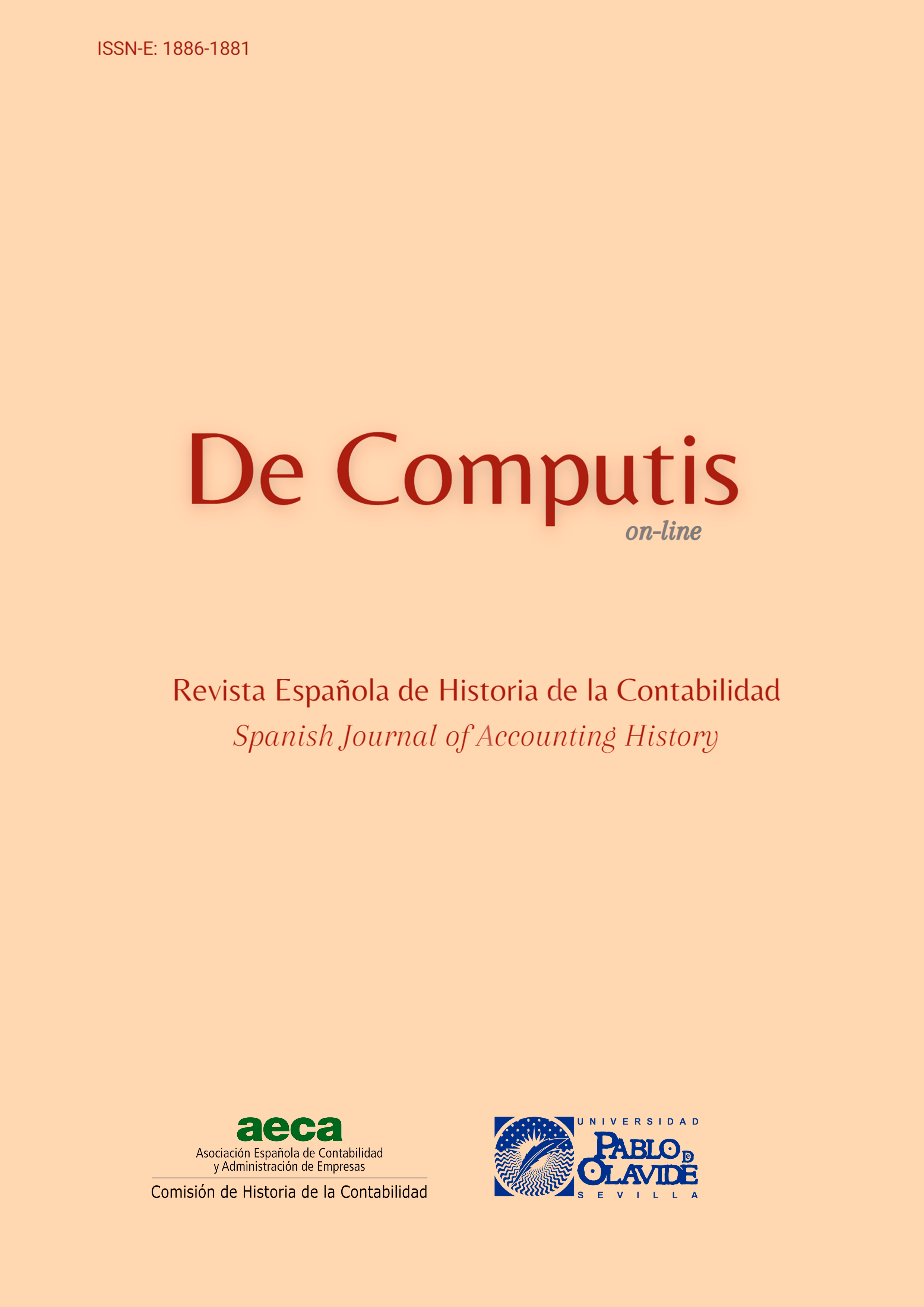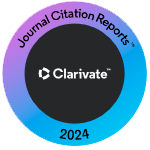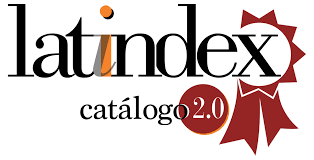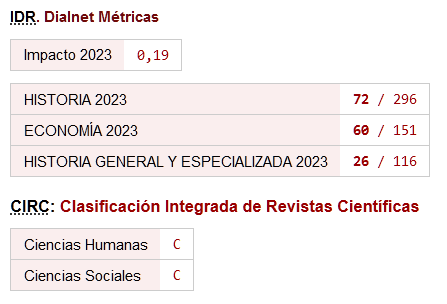Accounting System and Practices at Jerónimos Monastery (Portugal)
An Analysis of the Book of Expenses and Receipts at the End of 1833
DOI :
https://doi.org/10.26784/issn.1886-1881.22.1.12069Mots-clés :
monastic accounting, accounting history, Jerónimos Monastery, charge and discharge system, accounting system, accounting practices, PortugalRésumé
This paper aims to present the accounting system and practices of the Monastery of Santa Maria de Belém, best known as Jerónimos Monastery, in Lisbon, Portugal, during its last reporting period (1833). Primary sources of data for this research were the accounting books deposited at Torre do Tombo Library. A detailed analysis was conducted on one key document, Book 14: Book of Expenses and Receipts of the Monastery (1833), offering valuable insights into monastic accounting practices.
The Monastery accounting system is composed of five books, each corresponding to a distinct area of activity: three books of expenses and receipts, from the Monastery, the Farm and the Sacristy; one book of repairs and house improvements and another book of rents, interest, and land tenure. An additional book was prepared specifically for inspection. Beyond religious functions, the activities of the Monastery included agriculture, property rentals, and land leases. The accounting practices show a concern in keeping track of expenses and receipts from all the activities mentioned.
The accounting cycle of the Monastery lasts one year, from October to September, aligned with its seasonal agricultural activities. Unlike modern accounting, the Monastery did not use the double-entry bookkeeping system, nor the accruals concept. Instead, it adopted the charge and discharge system and cash-based accounting.
Summary accounts were prepared by the scribe and approved by the In Capite President (or General Abbot) and the deputies, every three or four months. Book 14 was prepared for inspection and proves the importance of, and attention given to the control of the accounting records. An analysis of Book 14, along with browsing the remaining books, showcases a well-established accounting system and underscores the emphasis placed on financial oversight and accountability.
The findings reveal that Jerónimos Monastery maintained a structured and transparent accounting system, which proved to be useful in capturing its economic operations. These records not only facilitated internal financial control but also offer valuable historical insights into monastic accounting practices of the time.
Téléchargements
Références
Alves.Caetano, A. (2020). Ferfídia – Conde do Farrobo. Edição do autor. Lisboa.
Araújo, D. (2010). A Contabilidade no Mosteiro de Santa Ana de Viana do Castelo nos Séculos XVIII e XIX. Dissertação de Mestrado. Universidade do Minho. https://repositorium.sdum.uminho.pt/handle/1822/16518.
Araújo, D. & Gomes, D. (2014). Contabilidade e Religião: O caso do Mosteiro de Santa Ana de Viana do Castelo (séc. XVIII e XIX) VII Encontro de História da Contabilidade da Ordem dos Técnicos Oficiais de Contas. https://www.occ.pt/fotos/editor2/delfinagomesehc2014.pdf
Barnabè, F. & Ruggiero, P. (2004). Contabilità e Controllo in un Ente Monastico: Monte Oliveto Maggiore nel XIX Secolo. Contabilità e Cultura Aziendale, 4(2): 211–214. https://hdl.handle.net/11365/11763.
Booth, P. (1993), Accounting in Churches: A Research Framework and Agenda. Accounting, Auditing & Accountability Journal, 6(4):37-67. https://doi.org/10.1108/09513579310045684.
Brandão, M. & Oliveira, J. (2012). Account Books and the Use of Accounting in the Monastery of Arouca, 1786-1825. In The Economics of Providence: Management, Finances and Patrimony of Religious Orders and Congregations in Europe, 1773-CA. 1930, Leuven, Belgium: Leuven University Press, 267-293. https://doi.org/10.2307/j.ctt9qf157.15
Carmona, S., Ezzamel, M. & Gutiérrez, F. (2004). Accounting History Research: Traditional and New Accounting History Perspectives. De Computis - Spanish Journal of Accounting History, 1(1): 24-53. https://doi.org/10.26784/issn.1886-1881.v1i1.239.
Carmona, S. & Ezzamel, M. (2006). Accounting and Religion: A Historical Perspective. Accounting History, 11(2): 117–127. https://doi.org/10.1177/1032373206063109.
Carmona S & Ezzamel M (2009). Religion. In: Edwards J and Walker S (eds.) The Routledge Companion to Accounting History. New York: Routledge, 503–523.
Carnegie, G. & Napier, C. (1996). Critical and Interpretive Histories: Insights into Accounting’s Present and Future through its Past. Accounting, Auditing & Accountability Journal, 9(3): 7–39. https://doi.org/10.1108/09513579610121956.
Carvalho, C. (2019). A influência das Práticas Contabilísticas no Processo de Criação da Diocese de Santarém. Dissertação de Mestrado. Escola Superior de Gestão e Tecnologia, Santarém. http://hdl.handle.net/10400.15/2705
Centorrino, G.; Naciti, V. & Schifilliti, V. (2024), One Faith for Different Realities: Accounting and Management Practices of Benedictine Monasteries. Journal of Management History, ahead-of-print. https://doi.org/10.1108/JMH-04-2024-0049
Cillanueva, M. A. (2009). Cobros y Pagos para la Edificación de una Catedral: Segovia 1524-1699.” De Computis: Revista Española de Historia de la Contabilidad 6 (10): 157–182. https://doi.org/10.26784/issn.1886-1881.v6i10.140
Cinquini, L.; Marelli, A. & Tenucci, A. (2008). An Analysis of Publishing Patterns in Accounting History Research in Italy, 1990-2004. The Accounting Historians Journal, 35(1):1-48. https://www.jstor.org/stable/40698366. https://doi.org/10.2308/0148-4184.35.1.1
Cordery, C. J. (2015). Accounting History and Religion: A Review of Studies and a Research Agenda. Accounting History, 20(4), 430-463. https://doi.org/10.1177/1032373215610590
Dobie, A. (2008a). An Analysis of the Bursars’ Accounts at Durham Cathedral Priory, 1278-1398. Accounting Historians Journal, 35(2): 181-208. https://www.jstor.org/stable/pdf/40698395.pdf. https://doi.org/10.2308/0148-4184.35.2.181
Dobie, A. (2008b). The development of financial measurement and control in monastic houses and estates in England c. 1200–1540. Accounting, Business & Financial History, 18(2): 141–159. https://doi.org/10.1080/09585200802058677.
Dobie, A. (2011). A Review of the Granators’ Accounts of Durham Cathedral Priory 1294–1433: An Early Example of Process Accounting?. Accounting History Review, 21(1): 7-35 https://doi.org/10.1080/21552851.2011.548178.
Dobie, A. (2015). The Role of the General and Provincial Chapters in Improving and Enforcing Accounting, Financial and Management Controls in Benedictine Monasteries in England 1215–1444. The British Accounting Review, 47(2): 142–158. https://doi.org/10.1016/j.bar.2014.09.003
Donoso Anes, R. (2005). Estado Actual de la Investigación en Historia de la Contabilidad: Perspectives on Present Accounting History Research. Revista de Contabilidad - Spanish Accounting Review, 8(15): 19–44.
Faria, A. (2008). An Analysis of Accounting History Research in Portugal: 1990—2004. Accounting History, 13(3): 353-382. https://doi.org/10.1177/1032373208091532
Fernandes, M. (1992). O Mosteiro de Santa Clara do Porto em Meados do Século XVIII (1730- 80). Porto, Arquivo Histórico, Câmara Municipal do Porto. Available at Repositório Aberto da Universidade do Porto: O Mosteiro de Santa Clara do Porto em meados do séc. XVIII: (1730-80)
Gallego, E.; Rivero, D. & Ramos, A. (2007). Los Flujos de Efectivo en una Economía Monástica. Estudio del Arca de la Comunidad del Monasterio de Santa María la Real de Oseira (1614-1698). De Computis - Revista Española de Historia de la Contabilidad. 4(6):3-31. http://dx.doi.org/10.26784/issn.1886-1881.v4i6.181.
Gomes, D. & Rodrigues, L. L. (2017). Investigação em História da Contabilidade, in M. J. Major e R. Vieira (org.). Contabilidade e Controlo de Gestão. Teoria, Metodologia e Prática, 2nd Ed. (pp. 211-239). Lisboa, Escolar Editora.
Gomes, D., Maran, L. & Araújo, D. (2022). Accounting in the Organisation and Life of a Religious Institution: The Monastery of Santa Ana in the eighteenth century. Accounting History, 27(4): 607-638. https://doi.org/10.1177/10323732221095628.
Gomes, S. (2011). Um registo de Contabilidade Medieval do Mosteiro de S. Jorge de Coimbra (1257-1259). Medievalista, 10. URL: http://journals.openedition.org/medievalista/118; https://doi.org/10.4000/medievalista.118
Gonçalves da Silva, F. (1982) A Contabilidade do Mosteiro de Alcobaça – Curiosidades e Velharias. Revista de Contabilidade e Comércio, 181(2): 219–223.
Gonçalves da Silva, F. (1985). A Contabilidade do Mosteiro de Alcobaça. In: Curiosidades, Velharias e Miudezas Contabilisticas, 2nd edition, Lisboa, Editorial Império.
Hernández-Esteve, E. (1984). Las cuentas de Fernán López del Campo, primer Factor General de Felipe II para los reinos de España (1556-1560) Contribución al estudio de la contabilidad y de la Hacienda Pública en la España del siglo XVI. Hacienda Pública Española 87: 85–105.
Hernández-Esteve, E. (2000). Presentation. In Accounting and History – A Selection of papers presented at the 8th World Congress of Accounting Historians, 5-17, Madrid: Caja Madrid.
Hernández-Esteve, E. (2008). Some Reflections on the Orientations and Volume of Accounting History Research in the 21st Century. De Computis - Spanish Journal of Accounting History, 9: 97-135. https://doi.org/10.26784/issn.1886-1881.v5i9.280
Jacinto de S. Miguel, F. (1901). Mosteiro de Belém – Relação da Insigne e Real Casa de Santa Maria de Belém. Lisbon, Typographia da Academia Real das Sciencias, Exemplar 117/1000.
Jones, M. J. (2009). Origins of medieval Exchequer accounting. Accounting, Business & Financial History, 19(3): 259–285. https://doi.org/10.1080/09585200802667147.
Jones, M. J. (2018). Domesday book: An early fiscal, accounting narrative?, The British Accounting Review, 50(3): 275-290.DOI: 10.1016/j.bar.2017.10.002
Leardini, C. & Rossi, G. (2013). Accounting and Power in Religious Institutions: Verona’s Santa Maria della Scala Monastery in the Middle Ages. Accounting History, 18(3): 415–427. https://doi.org/10.1177/1032373213487336
Llibrer Escrig, I., & Villaluenga de Gracia, S. (2023). Learning from history. Deconstructing the charge-and-discharge system within an accountability context. Accounting History Review, 33(1): 1–27. https://doi.org/10.1080/21552851.2023.2207609
Llopis, E., Fidalgo, E. & Mendez, T. (2002). The “Hojas de Ganado” of the Monastery of Guadalupe, 1597-1784: an Accounting Instrument for Fundamental Economic Decisions. Accounting, Business & Financial History, 12(2): 203-229. https://doi.org/10.1080/09585200210134929.
Malheiro, M. (2018). A Contabilidade Praticada no Mosteiro de São Salvador de Palme durante o Século XVIII. Dissertação de Mestrado. Universidade do Minho. http://repositorium.sdum.uminho.pt/handle/1822/59441.
Malheiro M. (2024). A contabilidade da Congregação de São Bento de Portugal no século XVIII. Dissertação de Mestrado. Universidade do Minho. https://repositorium.sdum.uminho.pt/handle/1822/88284.
Martins, C., (2010). The Accounting System of the Hieronymite Monastery of Santa Maria de Belém circa 1833. Dissertação de Mestrado. Nova School of Business and Economics. http://hdl.handle.net/10362/
Maté L., Prieto B. & Tua Pereda J. (2004). Financial Activity of the Silos Monastery in the Light of its Account Books. De Computis - Spanish Journal of Accounting History, 1(1): 97–141. DOI:10.26784/issn.1886-1881.v1i1.242
Maté, L., Prieto, B. & Tua Pereda, J. (2008). Contabilidad, Información y Control en un Contexto de Actividades Económicas Diversificadas en la Edad Moderna: El Monasterio de Silos y su Sofisticado Sistema Contable. De Computis - Spanish Journal of Accounting History, 9(9): 136–229. https://doi.org/10.26784/.1886-1881.v5i9.151.
Maté, L., Prieto, B., & Santidrián, A. (2017). El Papel de la Contabilidad Monástica a lo Largo de la Historia en el Orbe Cristiano. Una Revisión. Revista de Contabilidad - Spanish Accounting Review, 20(2), 143–156. https://doi.org/10.1016/j.rcsar.2016.10.003
Maté, L. M., Prieto, B., & Santidrián, A. (2021). The Transfer of Accounting Technologies within a Religious Order: the case of the Monastery of Silos (Spain) in the Nineteenth Century. Spanish Journal of Finance and Accounting / Revista Española de Financiación y Contabilidad, 51(1), 102–131. https://doi.org/10.1080/02102412.2021.1894804
Mendes, I. M. R. (1994). O Mosteiro de Guadalupe e Portugal: Séculos XIV-XVIIl. Contribuição para o Estudo da Religiosidade Peninsular. Lisboa: JNICT; Centro de História da Universidade de Lisboa, 509 pp.
Miranda, N. (2023). A Contabilidade no Mosteiro de Santa Maria de Alcobaça nos Finais do Século XVIII. Dissertação de Mestrado. Escola Superior de Gestão e Tecnologia, Santarém. Disponível em https://repositorio.ipsantarem.pt/handle/10400.15/4446.
Montrone, A. & Chirieleison, C. (2009). Traces of Double Entry in a Monastic Community: The Accounting of the Abbey of San Pietro in Perugia 1461-1464. De Computis - Spanish Journal of Accounting History, 10, 239-263. https://doi.org/10.26784/issn.1886-1881.v6i10.143
Oliveira, A. (1974). A Abadia de Tibães e o seu Domínio (1630-1680): Estudo Social e Económico. Porto, Publicações da Faculdade de Letras do Porto.
Oliveira, A. (1979). Contabilidades Monásticas e Produção Agrícola durante o Antigo Regime: Os Dízimos do Mosteiro de S. Tirso 1626-1821. Porto, Publicações da Faculdade de Letras do Porto.
Oliveira, J. (2005). The Accounting System of the Monastery of Arouca: 1786-1825: The Case Study of the Economic and Administrative Governance of a Feminine Cistercian Monastery. Arouca: RIRSMA.
Pereira, P. (2011). Arte Portuguesa: História Essencial. Lisboa: Círculo de Leitores; Temas e Debates, 434-444.
Prieto, B, Maté, L & Tua Pereda, J. (2006). The Accounting Records of Monastery of Silos throughout the Eighteenth Century: The Accumulation and Management of its Patrimony in the Light of its Accounts Books. Accounting History, 11(2): 221–256. https://doi.org/10.1177/1032373206063115.
Prieto B. & Gutiérrez, F. (2018). Tendencias en la Producción Científica en Historia de la Contabilidad. De Computis - Spanish Journal of Accounting History 15(2). doi: http://dx.doi.org/10.26784/issn.1886-1881.v15i2.331.
Rappazzo, N.; Marisca, C. & Sargiacomo, S. (2024). Tracing the Evolution of Accounting History Research in the New Millennium: A Bibliometric Analysis of Publication Patterns in Specialist Journals, Accounting Historians Journal, 1–27. Available at https://ricerca.unich.it/retrieve/8e17cc7c-42db-4046-bd4d-ae9267d28075/aahj-2023-037.pdf
Ribeiro, V. (2015). A Contabilidade no Convento de Nossa Senhora dos Remédios em Braga nos Séculos XVIII e XIX. Dissertação de Mestrado. Universidade do Minho. https://hdl.handle.net/1822/34961.
Rivero D.; Gallego E. & Ramos A. (2005) Accounts Rendering at the Cistercian Order in Castile: the ‘Book of Statements’ of the Monastery of Oseira (1614–1832). De Computis - Spanish Journal of Accounting History, 2(2): 81–198.
Rivero, D., Gallego, E. & Ramos, A. (2023). La Rendición de Cuentas en la Orden del Cister de Castilla: el Libro de Estados del Monasterio de Oseira (1614-1832). De Computis - Revista Española de Historia de la Contabilidad, 2(2). 81-198. https://doi.org/10.26784/issn.1886-1881.v2i2.232
Rivero, D.; Gallego, E.; Ramos, A. & Tua, J. (2005): Economía y Contabilidad Monásticas en la Transición del Antiguo al Nuevo Régimen. El Monasterio de Santa María la Real de Oseira. Ourense: Ed. Diputación Provincial de Ourense.
Rodrigues, L. L., Gomes, D., & Craig, R. (2004). The Portuguese School of Commerce, 1759-1844: a reflection of the "Enlightenment." Accounting History, 9(3), 53-71. https://doi.org/10.1177/103237320400900304.
Rodrigues, R. (2017). Tempos de Mudança, Tempos de Perda: o Património Conventual Português no Século XIX. Testemunhos de Vandalismo. Universidade de Lisboa. http://hdl.handle.net/10451/38065.
Ryan, B., Scapens, R. & Theobald, M. (2007). Research Method & Methodology in Finance & Accounting. London: Thomson, Dexter Haven Associates Ltd.
Santos, C. (1980). Os Jerónimos em Portugal: das Origens aos Fins do Século XVII, Instituto Nacional de Investigação Científica: Centro de História da Universidade do Porto.
Serrão, J. (1996). História de Portugal. O Despotismo Iluminado (1750–1807). VI. Lisboa: Editorial Verbo.
Silva, C. da; Boytaca, D., & Castilho, J. (1925). Mosteiro dos Jerónimos (História e Descrição). 3rd edition. Lisbon: Henrique Torres Editor.
Silva, M. (2010). A contabilidade do Mosteiro de S. Martinho de Tibães nos Séculos XVIII e XIX. Dissertação de Mestrado, Universidade do Minho, Braga. http://repositorium.sdum.uminho.pt/handle/1822/16818.
Sibilio, B., & Vannini, I. E. (2020). Development of the Administrative-Accounting System of the Conservatorio S. M. degli Angiolini in Florence from 1785 to 1859: Institutional Changes and Isomorphic Pressures. Accounting History, 25(2), 261-280. https://doi.org/10.1177/1032373219882436
Sousa, A. (1837). Descripção do Real Mosteiro de Belém com a Notícia da sua Fundação pelo Abbade A.D. Castro e Sousa. Lisbon: Typographia de A.I.S. de Bulhões.
Téléchargements
Publiée
Comment citer
Numéro
Rubrique
Licence
© Leonor Fernandes Ferreira, Cátia Martins 2025

Ce travail est disponible sous licence Creative Commons Attribution - Pas d’Utilisation Commerciale - Partage dans les Mêmes Conditions 4.0 International.










